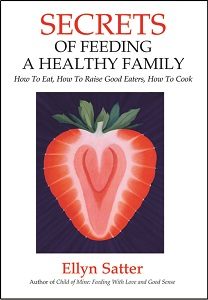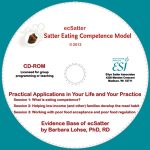

Family Meals Focus
The Ellyn Satter Institute Newsletter
Dietary Guidelines 2010 and eating competence
by Ellyn Satter, Registered Dietitian and Family Therapist
I endorse the DG 2010 goals of healthy weight and nutritionally adequate diet. However, the methods and attitude are inconsistent with ecSatter and, if followed, will undermine Eating Competence (EC). Rather than using prescriptive tactics, the eating competence approach is to encourage people to have regular meals and snacks and trust themselves to eat well and weigh what they need to weigh.
I registered objections to the committee
The goals in the recently released 2010 Dietary Guidelines (DG 2010) are 1) Maintain calorie balance over time to achieve and sustain a healthy weight. 2) Focus on consuming nutrient-dense foods and beverages.1 According to the press release, to achieve these goals, enjoy your food, but eat less; avoid oversized portions; make half your plate fruits and vegetables; switch to fat-free or low-fat (1%) milk; compare sodium in foods like soup, bread, and frozen meals, and choose the foods with lower numbers; drink water instead of sugary drinks. Here is the prescribed-maximum 2000 character comment that I submitted to the committee on April 21, 2009.
Given the complexity in our food supply, defining superiority in food selection is an impossible task, and a risky one. Particularly in these stressful economic times, endorsing one food or dietary philosophy over another can be tantamount to telling consumers they are eating inferior food, or, worse, telling parents they are giving their children inferior food. Instead of letting yourselves be bogged down by micro-managing food selection, think in broader and more inclusive terms. Support positive eating attitudes and behaviors.
According to research published in the Fall 2007 supplement to the Journal of Nutrition Education and Behavior, the Satter Eating Competence Model (ecSatter) is being positive, comfortable and flexible with eating as well as matter-of-fact and reliable about getting enough to eat of enjoyable and nourishing food. ecSatter is predicated on the utility and effectiveness of biopsychosocial processes: hunger and the drive to survive, appetite and the need for pleasure, the social reward of sharing food, and the biological propensity to maintain preferred and stable body weight.
Adults who score high on the Satter Eating Competence Inventory (ecSI) have indicators of better diets and have weights that tend toward the average. They also show better health indicators: They have higher high-density lipoprotein, lower blood pressure (even when stress-tested), lower total cholesterol and low-density lipoprotein, and lower triglycerides.
To support eating competence, go back to supporting nutritional adequacy, and leave medical nutrition therapy to the clinical dietitians. Give basic information, then trust consumers, and the process, to bring themselves along.
I endorse the Dietary Guidelines goals but not the method
The problem is with the Dietary Guidelines’ prescriptive implementation tactics, not the guidelines themselves.
I endorse the DG 2010 goals of healthy weight and nutritionally adequate diet. However, the methods and attitude are inconsistent with ecSatter and, if followed, will undermine Eating Competence (EC).
- EC is a trust model.2 It recognizes that when eating and feeding are positive and reliable, people bring themselves along with respect to improving the nutritional quality of their diets. Conversely, when the joy goes out of eating, nutrition suffers.3 DG 2010 is a control approach: it concerns itself with dietary and health indiscretions and tells people what they must do to correct those indiscretions.
- EC is a health at every size model. It supports achieving calorie balance and sustainable weight – as well as health – through interaction of its four components: Positive attitudes, food acceptance, internal regulation, and food context. DG 2010 repeats earlier ineffective and even harmful4 prescriptions: low calorie, low sodium5 food that is low in total fat and saturated fat and relatively high in monounsaturated and polyunsaturated fat.6
- EC achieves nutritional adequacy via enjoying an ever-increasing variety of food at family meals.7 DG 2010 attempts to achieve nutritional adequacy by telling people what and how much to eat.
- EC recognizes that people who are economically strapped and struggling to get enough to eat can’t be expected to eat off the apex of the food hierarchy.8 DG 2010 asserts that “This dietary guidance can help [low income people] maximize the nutritional content of their meals within their resource constraints.”
- EC emphasizes the primary importance of eating enjoyment.2 Except for the oxymoron in the press release (how can you possibly enjoy eating if you have to go hungry?), in DG 2010, the word enjoy appears twice with the mandate to enjoy recommended foods: “…require Americans … to select nutrient-dense foods and beverages they enjoy.” “Enjoy a wide variety of fruits.” For a third mention, see below.
- EC emphasizes the central importance of rewarding meals in supporting positive eating attitudes, food acceptance, and food regulation.9 DG 2010 is ambiguous about meals: “select an eating pattern that they enjoy and can maintain over time.” Otherwise, meals are discussed as a venue for weight management: “Prepare and pack healthy meals at home….” “Instead of eating out, cook and eat more meals at home.”
Becoming eating competent allows achieving Dietary Guidelines
Given these contradictions, what can the clinician or nutrition educator do? Failing to follow nutrition policy can feel like breaking the law! It need not be so. Keep in mind that the contradiction is with method, not with the guidelines themselves. Rather than using prescriptive tactics, encourage people to have regular meals and snacks and trust themselves to eat well and weigh what they need to weigh. Keep in mind that nutrition policy applies to populations. We work with one person at a time. We can join with each person right where they are and support their realistic, rewarding, and sustainable efforts to feed themselves and their families.10 We can do this, confident that supporting their foodways will in the long run will allow them to do the best they can to achieve the goals of DG 2010.
References
- United States Department of Agriculture. Dietary Guidelines for Americans, 2010. Accessed 12-11-2016.
- Satter EM. Eating Competence: definition and evidence for the Satter Eating Competence Model. J Nutr Educ Behav. 2007;39 (suppl):S142-S153.
- Satter EM. Chapter 1, The Secret in a Nutshell. Secrets of Feeding a Healthy Family: How to Eat, How to Raise Good Eaters, How to Cook. Madison, WI: Kelcy Press; 2008:1-14.
- Satter EM. Appendix C, What surveys say about our eating. Secrets of Feeding a Healthy Family: How to Eat, How to Raise Good Eaters, How to Cook. Madison, WI: Kelcy Press; 2008.
- Satter EM. Appendix O, Sodium in your diet. Secrets of Feeding a Healthy Family: How to Eat, How to Raise Good Eaters, How to Cook. Madison, WI: Kelcy Press; 2008.
- Satter EM. Appendix D: Diet and degenerative disease: It’s not as bad as you think. Secrets of Feeding a Healthy Family: How to Eat, How to Raise Good Eaters, How to Cook. Madison, WI: Kelcy Press.; 2008.
- Lohse B, Satter E, Horacek T, Gebreselassie T, Oakland MJ. Measuring Eating Competence: psychometric properties and validity of the ecSatter Inventory. J Nutr Educ Behav. 2007;39 (suppl):S154-S166.
- Satter EM. Hierarchy of food needs. J Nutr Educ Behav. 2007;39 (suppl):S187-188.
- Satter EM. Appendix B, What the research says about meals. Secrets of Feeding a Healthy Family: How to Eat, How to Raise Good Eaters, How to Cook. Madison, WI: Kelcy Press; 2008:227-230.
- Satter EM. Dietary Guidelines and Food Guide Pyramid incapacitate consumers and contribute to distorted eating attitudes and behaviors. Health at Every Size. 2005;19(3):161-170.
Explore
Chapter 5, “Feed yourself faithfully,” in Ellyn Satter’s Secrets of Feeding a Healthy Family tells you how you can trust yourself to eat what you enjoy and be healthy.
To learn more about EC and apply it to achieve nutrition and wellness goals, see the Satter Eating Competence Model Series on CD.
Related issues of Family Meals Focus
- Eating competence and nutrition facts labels
- Eat what you like and be healthy!
- Practicing nutritional judo
- Should you control portion sizes?
- Should you follow MyPlate?
- Should you put your child on skim milk?
- Stop being hysterical about “obesity!”


